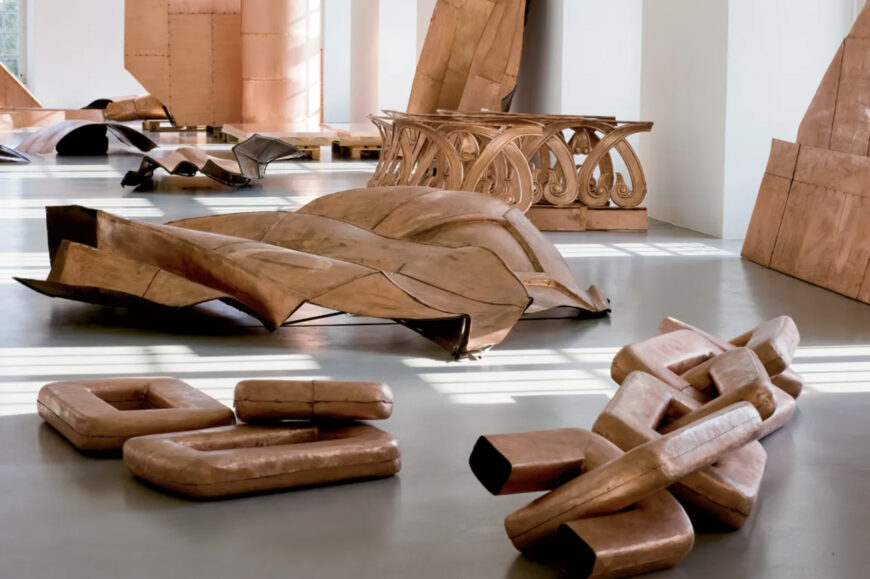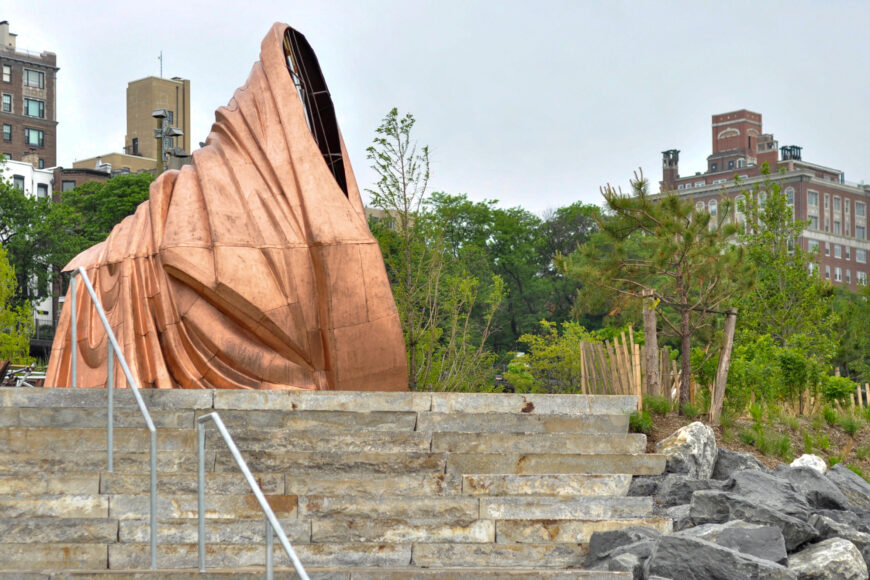
Danh Vo, We the People, in Brooklyn Bridge Park, 2011–14, copper (photo: Hrag Vartanian, CC BY-ND 2.0) © Danh Vo
A large structure made of bright shiny copper at Brooklyn Bridge Park in New York City overlooks the Hudson River. The object is round and conical and tapered at the top, with deep curvilinear ridges covering the entire surface. An elongated aperture dominates the upper half of the front. An elaborate cage-like scaffold made of poles that supports the hollow metal structure is visible at the back and through the opening at the top. The joints between the copper sheets are also visible; the most prominent one in the middle runs the entire circumference. While the object can be identified as one section of a larger depiction of drapery hanging in space (the ridges look like folds from a distance), the specific identity of the garment remains elusive.
300 components
The copper construction is one of the about 300 components of a full-scale replica of the Statue of Liberty, a sculpture project by the Danish conceptual artist Danh (pronounced “Yann”) Vo titled We the People. The conical object described above is a portion of the fabric that gathers around Liberty’s upper right arm as she holds a torch high above her head. The pieces were never meant to be assembled, and are exhibited simultaneously at multiple international venues, both indoors and outdoors. For instance, fifty sections were displayed at Brooklyn Bridge Park and City Hall Park in Manhattan for several months in 2014. While each fragment is a clue to the historic statue, it is unlikely that a viewer—except when confronting a recognizable body part, such as the toes or a section of the hand holding the torch—would be able to connect any of them to the original without contextual information. Though Vo had never seen the Statue of Liberty when he embarked on the project, he was aware of its history and the technique of its making. His attention to the monument stemmed from his strong interest in American and French history, which, in turn, is tied to his personal story.
Trung Ky-Danh Vo was born in Vietnam in 1975, near the end of the country’s prolonged conflict with the United States. When he was four years old, fear of political retaliation forced his family to attempt to reach the United States by boat. They narrowly escaped death when a Danish freighter rescued them, and the family eventually settled in Denmark.

Marine CH-46A Sea Knight helicopter, Squadron 265 near Da Nang, Vietnam, c. 1968, photographed by Sergeant V.J. Hale Jr. (Department of Defense, NARA)
Indochina and Vietnam Wars
Vo is drawn to the complex geopolitical roles of both France and the United States. France helped the American colonies in their revolutionary war against Great Britain, and gave the Statue of Liberty as a gift to commemorate the centenary of American independence in 1876. American citizens paid for its base, while French citizens provided the funds for the statue. Yet in that same period, France colonized Vietnam following its victory in the Sino-French War in 1884–85, an occupation that only ended with France’s defeat in the First Indochina War in 1954. Almost immediately following the French withdrawal, the United States wreaked unspeakable destruction in Vietnam between the mid-1950s and the mid-1970s under the pretext of liberating the country from Communism. For Vo, the statue is thus a symbol of the double standard of colonial powers like the United States and France, celebrating democracy at home while pursuing violent expansionist goals abroad. He was also fascinated by the stark contrast between the strength and fragility that the statue embodies; it is, on the one hand, one of the most powerful symbols of freedom and democracy, with its monumental scale asserting much of that power; yet it is also a hollow structure shaped out of copper sheets with the thickness of two pennies, attached to a steel armature. Such contradictions are at the core of Vo’s conceptual framework for his sculpture project.
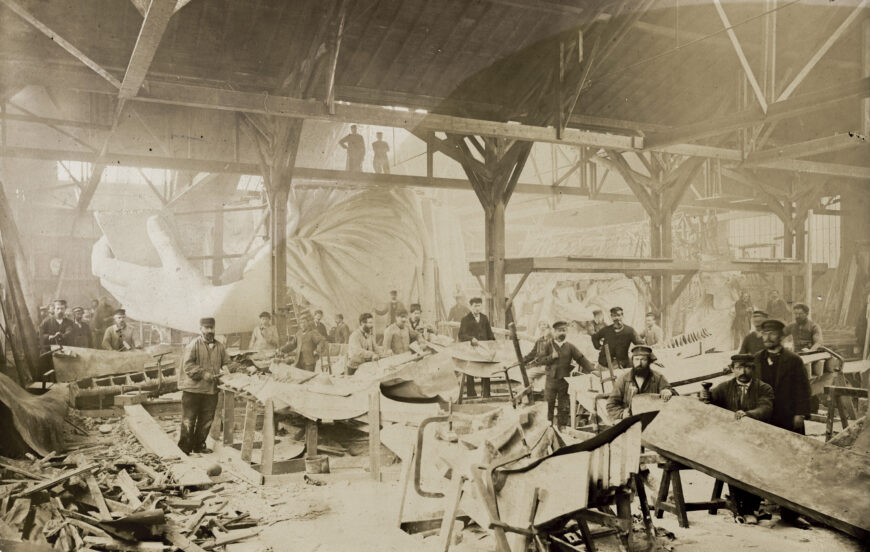
Hammering copper for the Statue of Liberty, Gaget, Gauthier & Co., Paris, c. 1881–83 (Library of Congress, Washington, D.C.)
Global exchange
While most of Vo’s projects involve pre-existing objects of historic significance, We the People was made from scratch. The idea of outsourcing a 1:1 replica of Lady Liberty first dawned on him after the second Gulf War began in 2003. He wanted to replicate the technique of repoussé—where a metal sheet is hammered on the reverse side to produce a relief—that had been used to make the original statue. Though initially his goal was to have the work produced in Europe, a metal fabrication company in Shanghai did it at a lower cost. The project, which took five years to complete and cost almost two million dollars, was funded by the Qatari art collector Sheikha al-Mayassa bint Hamad bin Khalifa al-Thani and Galerie Chantal Carousel, the Parisian gallery that represents Vo. The components have been exhibited in more than fifteen countries and many of them are now owned by private collectors. Based on a sculpture in the United States, planned in Germany, funded by Qatari money, supported by a European enterprise, produced in China, and exhibited internationally, the making and dissemination of the work effectively demonstrates art as commodity in a global exchange system.
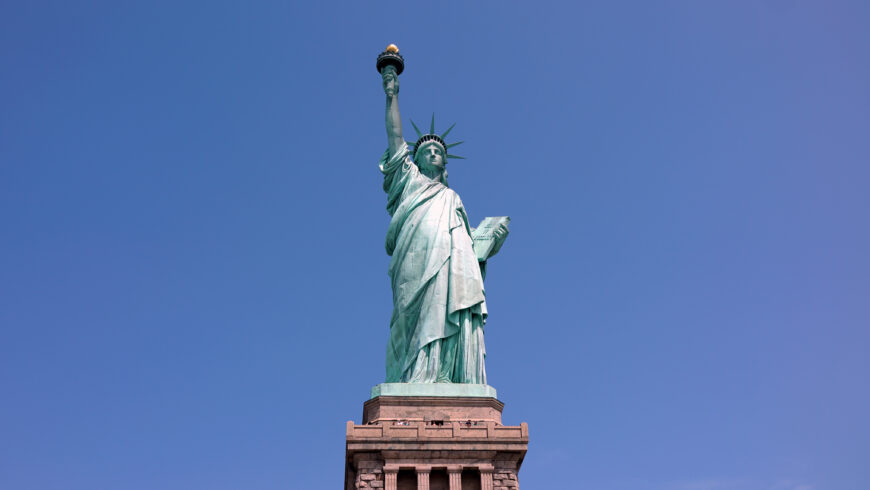
Frédéric-Auguste Bartholdi (sculptor), Gustave Eiffel (interior structure), Richard Morris Hunt (base), Statue of Liberty, New York Harbor, begun 1875, dedicated 1886, copper exterior, 46 m high (statue) (photo: Steven Zucker, CC BY-NC-SA 2.0)
The Statue of Liberty satisfies all the requirements of a monument: it is site-specific, permanent, and offers a cohesive bi-national narrative. We the People, in contrast, is fragmented, exhibited temporarily at various sites around the world, and dissects the symbolism of the original. In making a familiar icon seem unfamiliar, it qualifies as an “anti-monument.” Vo’s strategy of keeping the components separate is crucial to his intervention in the myths about the actual statue. The title of the project—the first three words of the Preamble of the American Constitution—is itself a fragment of a larger text; while one may choose to complete the phrase with the official version of the text, it also leaves room for alternatives.
Metaphors
The visible supporting structures of the fragments, evident in the Brooklyn example, can be regarded as metaphors for the artifice of Lady Liberty. By exposing the hidden fragility beneath her stable exterior, they draw attention to the fact that far from self-evident and inviolable, democracy and freedom are historical constructs that are subject to change, and they may face existential challenges (the disturbing political polarization in American society over the last few years and attempts at violent subversion of civil institutions vindicate this view). Thus, while the projection of nationalistic ideals and aspirations on the Statue of Liberty turned it into a universal ahistorical icon of freedom around the world, Vo strikes at the heart of that claim of universality by offering a historical lens.
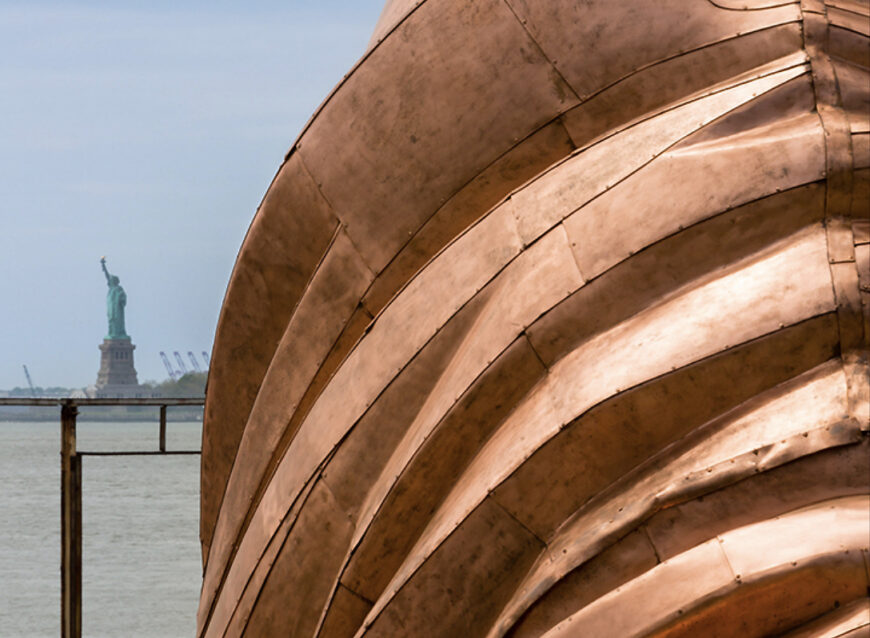
We the People with the Statue of Liberty visible in background (detail), Danh Vo, We the People, in Brooklyn Bridge Park, 2011–14, copper (courtesy of the artist, Galerie Chantal Crousel, Paris; photo: James Ewing courtesy Public Art Fund) © Danh Vo
Vo’s poetic gesture in splintering the replica of the celebrated monument, to deconstruct the homogeneity of its symbolism, is especially convincing when understood in the light of his own sense of displacement and the colonial history of his country of origin. A gay artist of Asian origin raised in a liberal Scandinavian culture, Vo was educated in Copenhagen before completing his art training in Frankfurt. He is now based in Berlin and Mexico City, with ties to Paris and New York. For such a polyglot transnational individual, the notion of self is never homogenous; always splintered and flexible, it thrives on the plurality offered by multiple intersections of identities. Belonging, for him, has always been an effort, resisting marginalization or exclusion by dominant cultures. On the one hand, the scarring of Vietnam due to French and American involvement for almost a century are responsible for the disruption, displacement, and hybridity of Vo’s life; on the other hand, the Statue of Liberty, for him, epitomizes the imperialist histories of those two nations in Vietnam cloaked in patriotic rhetoric.
Vo frees himself from the claustrophobic niche the art world routinely assigns to immigrant artists of color and performs in a more complex arena for self-expression. Never a whole, the sculpture, like his own life, remains fragmented, forever displaced, and scattered across countries. In fact, the artist himself does not have a clear idea of the current whereabouts of all the pieces, and no collector owns more than a few of them. The fragments exhibited in a gallery can be identified as abstract sculptures, but they behave differently in outdoor settings; they inevitably stand out from their sites with an ambiguous status between sculptures and unidentifiable objects.
The fragmented replica of Lady Liberty has caused unease among those who consider the wholeness of the statue essential for one’s commitment to the homogeneity of its symbolism and argue that institutionally endorsed heroic narratives are crucial to stable nationhood. Yet there is no question that Danh Vo’s creative approach offers fresh perspectives on history, culture, and identity, where the singularity of each fragment of We the People stands for the whole statue.
Additional resources

